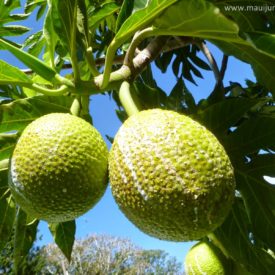This week, we have ‘ulu from Southern Turf.
‘Ulu or breadfruit was first domesticated in the western Pacific and today is grown on most Pacific Islands. It continues to be an important staple crop and a component of traditional agroforestry, grown as both a subsistence crop in home gardens and farms. As a dietary staple it is comparable in importance to tropical staples such as taro, plantain, cassava, sweet potato and rice. The name breadfruit is derived from the texture of ripe fruit when cooked, which is similar to freshly baked bread, though it has a potato like flavor. Ripe fruit have yellow or yellow-brown skin and soft, sweet, creamy flesh that can be eaten raw or cooked. ‘Ulu is a versatile crop and can be eaten at all stages of maturity. The fruit is a good source of dietary fiber, potassium, calcium, and magnesium.
It can be eaten in the raw state or steamed and pounded into poi or added to desserts and drinks. It can be fried, baked, or made into a gluten-free flour. In Hawaii, the traditional method of cooking is by roasting the fruit. It is also cooked in deep fire pits, called “imu.”
In its immature state before ripeness occurs, it’s cooked much like a green vegetable and tastes like artichokes.
You can also check this out for cooking ideas: https://eatbreadfruit.com/blogs/recipes/how-to-cook-breadfruit
What else is in the bag?
Try out these recipes!






